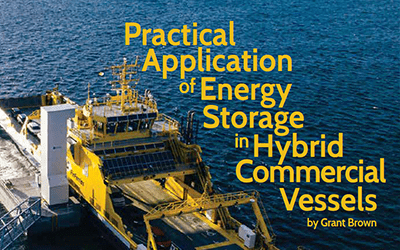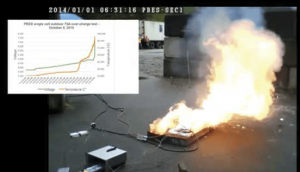
Excerpt from The Journal of Technology, written by Grant Brown, VP Marketing SPBES. Published November 2018. Read full article here.
Marine engineers have long been aware of the potential efficiency increases from hybridizing their onboard energy systems; the ability to optimize the use of diesel generators by storing excess energy and using it to provide propulsion during low load times. However, only recently has the battery technology been improved to the point of allowing large-scale systems to survive in a commercial marine environment. Not only do these new energy storage systems survive, they are designed for and excel in commercial marine environments. Hybrid tugboats, offshore supply vessels (OSV), ferries and a variety of other purpose built vessels all derive huge efficiencies from the use of onboard energy storage.
These hybrids range from new builds to retrofits of existing vessels. Payback on investment is a critical component in the decision to convert or build a hybrid workboat. However, an often overlooked benefit is the redundancy and increased safety offered to the operator of a hybrid vessel. A vessel employing a large battery or energy storage system (ESS) not only operates more efficiently, it also has an ability to draw upon a reserve of energy instantly. This pool of energy may be used as spinning reserve to keep the vessel from harm’s way in the event of power loss, provide emergency navigation and hotel loads, auxiliary propulsion power, and even extra bollard pull to the main drives in the event of an emergency situation while towing. While these and other advantages, such as the environmental and cost savings benefits, are well-documented, real world lessons learned by an experienced integration and engineering team are exceptionally valuable. This experience helps vessel owners, operators and designers understand how to design and integrate a lithium energy storage system for safe, reliable use, now and for years to come.
Simply put, batteries will reduce a vessel’s exposure to risk and make it fundamentally safer to operate, while providing economic gain for vessel owners.
Risks of Energy Storage
Despite the obvious advantages to a vessel using energy storage to increase efficiency, redundancy and safety, the batteries themselves may pose risk. Due to an event known as thermal runaway, the batteries, if not managed within certain and specific parameters, may pose risk of combustion.

Thermal runaway occurs if the lithium-ion cells used in marine batteries are subjected to electrical or mechanical abuse, suffer from internal manufacturing defects, or operate over or under the correct voltage or temperature. Heat is generated within the lithium-ion cells and in cases where this heat exceeds a specific temperature (usually in excess of 120˚ centigrade), the internal structure of the cell begins to degrade. This degradation results in the internal separators melting and thus causes a reaction between the cathode material and electrolyte. This can result in the cell temperature increasing until the cell vents toxic and flammable gases. If ignition occurs, these gases can create an unpredictable fire, which can be very difficult to extinguish.
Therefore it is extremely important to a) reduce risk by designing and manufacturing the highest quality product available, b) reduce risk by managing the batteries in the safest possible way and c) provide a system that is capable of containing and suppressing thermal runaway should it occur. While we have come to accept the risks of maintaining large quantities of flammable diesel on board a vessel, it is due to decades of experience that we now have very little incidence of diesel fire. This is due to trial and error, consistent regulation, and adoption of best practices for management of the systems.
The same learning curve is occurring in the marine industry regarding large-scale lithium batteries. Currently, regulations do not reflect the realities of the size and types of systems that are now being installed and while it is unfortunate, it may take some sort of significant incident to force the industry regulators to adopt stricter regulation.
Fire Suppression
Given the possible issues associated with fire and explosion, the class groups have spent a lot of time focusing on how to prevent and manage fires and thermal runaway. No matter the amount of care that the class rules can apply to prevention, it does not remove the battery manufacturers from the responsibility of incorporating sophisticated prevention systems into the design of the batteries. With lithium energy storage systems now regularly being discussed that exceed several MWh of capacity, the risk of thermal runaway or fire cannot be taken lightly. Today’s hybrid designs must take this into account and do everything possible to ensure that a fire cannot start in the first place. This has created a shift in thinking that is driving designs to incorporate liquid cooling systems. These liquid cooling systems manage battery safety inside the core of the module through temperature control and management at the cell level. Fire suppression is critically important but must be viewed as a secondary system to manage the issue in extreme circumstances, after all else fails. Fire suppression systems therefore are recommended to control external fires adjacent to the energy storage system to prevent them from causing a thermal event in the battery room. If desired, fire suppression in the battery room may also be employed to further give peace of mind as a backup system. Mist type fire suppression provides adequate cooling to suppress virtually any fire (outside of a major catastrophe involving the ship itself) that may pose a hazard to the energy storage system. In order to meet class standards, the energy storage system itself must be rated for IP67 water resistance and therefore able to safely withstand activation and use of mist type fire suppression.
Management Systems, Communications and Controls
Modern battery systems provide an ability to not only integrate with existing systems on board the vessel, but also increase longevity of system life and enhanced safety of the system. These systems reside inside the battery modules and the system controller, which in turn communicates with the other vessel power electronics. The Battery Management System (BMS) is able to predict module lifespan using complex algorithms that incorporate historical data and projected future use. This allows vessel owners to alter their use profile of the energy storage system to a) increase lifespan, b) increase vessel fuel efficiency, or c) a combination of both. The BMS is also an extremely important part of the safety system of the ESS. It constantly monitors the internal core temperature of the modules and if they are going out of spec (too hot or too cold), they will warn the vessel captain to limit use. The BMS is also able to actively monitor the state of health of the system within the temperature warnings; if a specific component in any one part of the entire system is out of spec, the system will warn the captain and the team who is monitoring it. The monitoring team will then proactively engage with the vessel and determine what, if any, course of action need be taken. If the warnings continue without intervention from the team, or if the vessel crew ignores the warnings, the system will protect itself and the vessel by disengaging from the DC bus and isolating all the modules in the system via their internal contactors, effectively reducing system voltage from a maximum of 1,000 V to ~100 V (the voltage of a single module). As the controls are powered separately from the ESS, they are safer in that there is redundancy in the system. It will always have an external power source ensuring the cooling system is operating and the management system is communicating with the vessel and system administrator team at all times, regardless of the system status.
Cooling Systems
While the industry standard for many years was passive cooling on all systems, it is increasingly apparent that the smaller systems demanded by industry are required to operate at, or beyond, the limits of passive cooling. Virtually all modern ESS employ some form of liquid cooling, either as an optional addition to the standard system or as an integral component. Advanced, state of the art ESS use individual cell level cooling systems; the coolant circulates within the very core of the battery module at a low pressure enabling far greater charge and discharge currents, increased lifespans, and reduced system sizes. In fact, the most modern of these systems has been validated to discharge approximately 16 times more power than the current industry standard product. Typically the ESS will connect to a standard chiller of specified size, using an inexpensive and small pump and be able to meet the very high demands with a far smaller system size and capacity with resulting cost savings benefits.
Conclusion
The new breed of hybrid commercial vessel is now a proven workhorse capable of huge economic and environmental benefits in virtually every application it is deployed (Figure 5). The added risk mitigation and increased safety has tangible value that should not be dismissed. No longer is the reduced cost of ownership from the decreased fuel consumption and maintenance outweighed by concerns about safety and reliability. As with any updated technology, lithium energy storage is new and system design is currently being refined, as are class rules regarding the use of the technology. As a co-founder of one of the early companies developing energy storage for hybrid marine systems, I have observed the industry develop, grow and mature. It is my assertion that the technology is gaining momentum by leaps and bounds. As it continues to evolve so will advances in the design and safety of the systems and increasingly strict regulations governing their use. The industry is now producing safe, reliable systems that provide meaningful financial benefits for the owners, safe operation for the crew and, ultimately, huge environmental benefits for the planet.
Read full article here.